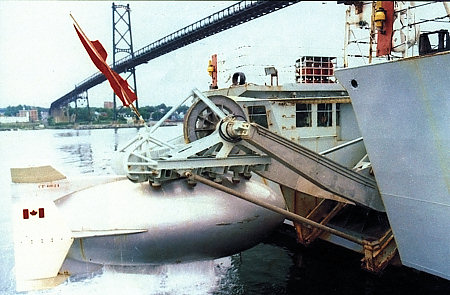Once of the benefits of having HMCS SACKVILLE in for refit is that we are able to access compartments that would normally be inaccessible. Two of those spaces are associated with the ship's original underwater sensor suite (originally knows as ASDIC, now better known as SONAR) as well as the former chain (or cable) locker, which I believe was retrofitted at some point to accommodate an underwater sensor of its own.
It should be noted that while much of the following has been contributed by others, more knowledgeable than I on ASDIC/SONAR, we are hoping to find someone who may have been familiar with the installations within SACKVILLE (or corvettes in general) either during the war or after during SACKVILLE's days as a loop layer and research vessel. In particular, my thanks to (in no particular order) Jerry Proc, Clive Kidd, Koji Kamori, and Norrie Millen for their observations and help in interpreting the fittings that remain in SACKVILLE.
In the section below, the ASDIC compartment is labelled as "NO. 1 STORE ROOM" just aft of the cable locker.
Viewed from the exterior of the hull, you can just see the through-hull penetrations from the ASDIC compartment on the left of the following image, with another through-hull penetration from the cable locker on the right.
All of these openings have been plated over to prevent leakage. Viewed from underneath, the ASDIC compartment penetrations can be seen clearly (aft is to the left, the bow is towards the right of this image):
And the opening from the cable locker:
ASDIC was originally developed during the First World War, but was still fairly primitive at the start of the Second World War. SACKVILLE was originally fitted with a Type 123 ASDIC, which was developed in the 1930s. From my writeup on the Haze Gray and Underway website:
"Due to the primitive electrical systems on the early corvettes, these ships had to rely on magnetic compasses, rather than more advanced and reliable gyro compasses. The reliance on magnetic compasses limited these ships to the older Type 123A sonar, as newer sonars required gyro compasses. The use of magnetic compasses alone was a limiting factor, as they were sensitive to the steel construction of the ships on which they were mounted, and tended to bounce around in heavy seas and when the corvettes were thrown about after dropping depth charges, which made it difficult to plot an accurate course.
These "primitive but reliable" sonar sets used an oscillator located under the hull which could be rotated through 360 degrees (by hand!), but was fixed at about 6 degrees below the horizontal. As a result, conditions under which a submarine could be located, and contact maintained, were limited. As the oscillator was fixed in elevation, a corvette was forced to lose contact with a targeted U-boat during the actual attack phase where the corvette passed over the U-boat to drop depth charges, and one tactic early in the war was for one corvette to stand off and hold the contact while another corvette went in for the attack. The development of the Hedgehog, and other "stand-off" weapons later in the war, also helped to overcome this shortcoming.
The improved 123D set came about merely by adding a second magnetic compass and bearing indicator on the bridge, and a loudspeaker system for the sonar operator to communicate directly with bridge personnel. The upgrade appears to have occurred sometime between 1942 and 1943 for some ships, but was never fully carried out in favour of other more improved sonar sets."
The underwater portion, or "hull outfit", of the Type 123 ASDIC unit looked very similar to the following diagram, which I have borrowed from Jerry Proc's excellent website, which he in turn borrowed from another website, and which probably originates from a book of some sort:

A labelled version follows:
In addition, the cable locker was fitted with a voice pipe, for purposes unknown. Another view of the cable locker, looking forward:
One of the two pad eyes still has the remains of a shackle attached to it - I'm guessing that the ends of the ship's two anchor chains might originally have been shackled to the pad eyes to prevent them from going overboard when dropping the anchor.
And if you're wondering - yes, that is the interior of the ship's hull plating on either side of the photo. When the ship is afloat, there is water on the other side of that steel plate. As a museum ship, SACKVILLE is ballasted down to compensate for a lack of fuel and ammunition, and all sorts of other kit that has been removed over the years. If you look closely on both the left and right of the photo, you can see the scum line left by ballast water, as this compartment would normally be full of water when she is afloat.
If anyone has comments or information that might be useful to add to this post, please leave it in a comment, and I will see what I can do to incorporate it.




























